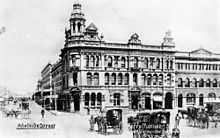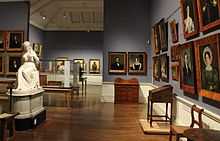Henry Hunter (architect)
| Henry Hunter | |
|---|---|
| Born |
October 10, 1832 Nottingham, United Kingdom |
| Died |
October 17, 1892 (aged 60) Brisbane, Australia |
| Nationality | Australian |
| Occupation | Architect |
| Buildings | Hobart Town Hall |
Henry Hunter (1832–1892) was a prominent Tasmanian architect and civil servant, best known for his work on churches. During his life was also at various times a state magistrate of Tasmania, a member of the State Board of Education, the Hobart Board of Health and a Commissioner for the New Norfolk Insane Asylum.[1]
Life
Hunter was born in Nottingham, England, son of Walter and Tomasina Hunter. His father was also an architect, and he studied the craft under his father before attending the Nottingham School of Design. He immigrated to Australia in 1846 with his two sisters and parents, originally settling in South Australia before moving to Tasmania where his older brother had already settled upon the death of his parents.
He worked in Tasmania for thirty seven years, before moving to Brisbane in 1888 where he opened an architectural firm with his former apprentice Leslie Corrie. Upon his departure a farewell dinner was organised by builders and architects of Hobart, attended by the Lord Mayor of Hobart, Premier of Tasmania and the state Attorney General.[2][3]

During his time in Brisbane he remained a prominent architect, being President of the Queensland Institute of Architects in 1890 and Vice President in 1891. His most notable works in Brisbane were additions made to the All Hallows' School convent and the design of the Queensland Deposit Bank.[3]
Works
- Hobart Town Hall[3]
- parts of the Tasmanian Museum and Art Gallery[3]
- Old Hobart Masonic Hall, Hobart[3]
- Old Marine Board Building, Hobart [3]
- St David's Cathedral (supervisor of 1st cathedral, demolished in 1860 due to faulty work. Second cathedral designed by Hunter)[3]
- St Mary's Cathedral (supervising architect)[2]
- St Mary's Anglican Church, Hagley[4]
- Church of the Apostles, Launceston[5]
- St James Anglican Church, Jericho[6]
- St Michael's Catholic Church, Campbell Town[7]
- St John's Church, Franklin[8]
- All Saints Anglican Church, South Hobart[9]
- The Mariners Church (now St Peters, Sandy Bay)[10]
- Macquarie Manor[11]
- Stonehenge House, Oatlands[12]
- Ashleigh House, Hobart[13]
- Glenelg House, Gretna[14]
- Airlie House, Hobart[13]
- Lebrena House, Hobart[13]
- 2 Mawhera Ave, Hobart[13]
- St Joseph's Orpangage, Hobart[15] (demolished)
- Tasmanian Steam Navigation Company Offices[15] (demolished)
- Derwent and Tamar Building, Hobart[3]
- AMP Building (demolished, entrance arch stands in Royal Hobart Botanical Gardens)[3]
- Presentation House, Sacred Heart Catholic Primary School, Launceston[16]
- Macquarie Street State School, Hobart (now former Macquarie St Adult Education building)[17][18]
- parts of All Hallows' Convent, Brisbane (with Corrie)[19]
- Queensland Deposit Bank and Building Society, Brisbane (with Corrie)[20]
- Eagle Farm Racecourse, Brisbane (with Corrie and JH Buckeridge)[21]
Legacy

The Henry Hunter Prize for Architect is a prize awarded triennially to architectural projects that involve the "recycling or conservation of historic buildings".[22] The Henry Hunter Galleries, the main permanent art exhibition at the Tasmanian Museum and Art Gallery are also named in his honour.[23]
In 2006 the architectural firm founded by him (presently known as Crawford Padas Shurman Architects) celebrated its 150th anniversary of continuous business.[24]
Several of his apprentices went onto be influential architects in their own right; Alan Cameron Walker went on to construct several other notable Tasmanian landmarks, including the General Post Office[25] and Leslie Corrie went on to become a prominent Brisbane architect and later Mayor of Brisbane.[26]
References
- ↑ "Henry Hunter". UTAS. Retrieved 5 Feb 2014.
- ↑ 2.0 2.1 "Henry Hunter". The Mercury. Retrieved 5 Feb 2014.
- ↑ 3.0 3.1 3.2 3.3 3.4 3.5 3.6 3.7 3.8 McDonald, D. I. "Hunter, Henry". Australian Dictionary of Biography. National Centre of Biography, Australian National University. Retrieved 5 February 2014.
- ↑ "St Mary's Anglican Church Hagley". ohta.org.au. Organ Historic Trust of Australia. Retrieved 3 October 2014.
- ↑ "THE NEW ROMAN CATHOLIC CHURCH". Launceston Examiner. 17 September 1864. Retrieved 11 December 2014.
- ↑ "Museums and Cultural Centres". southernmidlands.tas.gov.au. Municipality of the Southern Midlands. Retrieved 3 October 2014.
- ↑ "OPENING OF SAINT MICHAEL'S CHURCH, CAMPBELL TOWN". The Hobart Town Mercury. 5 October 1857. Retrieved 11 December 2014.
- ↑ "St Johns Anglican Church, Hall and Churchyard". environment.gov.au. Department of Environment. Retrieved 3 October 2014.
- ↑ "All Saints Restoration Project". heritage.tas.gov.au. Heritage Tasmania. Retrieved 3 October 2014.
- ↑ "Maritime Times of Tasmania". maritimetas.org. Maritime Museum of Tasmania. Retrieved 3 October 2014.
- ↑ "Macquarie Manor History". Macquarie Manor. Retrieved 5 Feb 2014.
- ↑ "Stonehenge homestead in the Oatlands district (Photograph)". catalogue.statelibrary.tas.gov.au. State Library of Tasmania. Retrieved 3 October 2014.
- ↑ 13.0 13.1 13.2 13.3 "Buying a little piece of history". The Mercury. 13 Jan 2013. Retrieved 3 October 2014.
- ↑ "'Glenelg', Gretna, Tasmania; 1963; TSO00018176". ehive.com. National Trust of Australia. Retrieved 20 February 2015.
- ↑ 15.0 15.1 "MR. HENRY HUNTER". The Mercury. 23 March 1888. Retrieved 11 December 2014.
- ↑ "The Sacred Heart Convent and School 1873 - now Presentation House". sacredhearthl.tas.edu.au. Sacred Heart Catholic Primary school. Retrieved 3 October 2014.
- ↑ "A treasured icon of South Hobart". Tasmanian Times. 14 October 2011. Retrieved 3 October 2014.
- ↑ "Sell-off raises hackles". The Mercury. 26 September 2011. Retrieved 3 October 2014.
- ↑ "All Hallows' Convent Chapel Ann Street, Brisbane". ohta.org.au. Organ Historic Trust of Australia. Retrieved 3 October 2014.
- ↑ "image appearing in Queensland Figaro". bishop.slq.qld.gov.au/. State Library of Queensland. Retrieved 3 October 2014.
- ↑ "Eagle Farm Racecourse and Ascot Railway Station". heritage-register.ehp.qld.gov.au. Department of Environment and Heritage Protection, State of Queensland. Retrieved 3 October 2014.
- ↑ "Port Arthur Wins Henry Hunter Prize". Port Arthur Historic Site. Retrieved 5 February 2014.
- ↑ . Tasmanian Museum and Art Gallery http://www.tmag.tas.gov.au/whats_on/exhibitions. Retrieved 24 Feb 2014. Missing or empty
|title=(help) - ↑ . Crawford Padas Shurman Architects http://www.architectsdesignhaus.com/about/150years.pdf. Retrieved 5 Feb 2014. Missing or empty
|title=(help) - ↑ "Alan Cameron Walker". Australian Dictionary of Biography Volume 12 1980. National Centre of Biography, Australian National University. Retrieved 5 Feb 2014.
- ↑ "Personal". Brisbane Courier. 10 Feb 1902. Retrieved 24 February 2014.